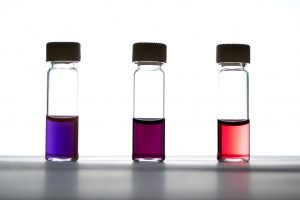
Gold nanoparticles are microscopic particles of gold measuring 1 to 100 nanometers in diameter. Due to their uniformity, conductance and optical properties, they have a variety of uses as sensors and catalysts and for biological imaging. Gold nanoparticles are also used in consumer electronics chip design as conductors and to connect resistors.
Colloidal gold—gold nanoparticles in a solution— has been used in health care since the fourth and fifth centuries B.C. in China, Arabia, and India. In Europe during the Middle Ages, Paracelsus, Swiss philosopher, alchemist, and astrologer, used it to treat mental illnesses and syphilis. Giovanni Andrea, a contemporary of Paracelsus, used colloidal gold to treat his patients’ leprosy, plague, epilepsy, and diarrhea.
In modern times, colloidal gold is used for photodynamic therapy, therapeutic agent delivery, and diagnostics. Photodynamic therapy, used to kill cancer cells, involves injecting a person’s bloodstream with colloidal gold. The gold particles stay in the tumor longer than in other cells. After a certain amount of time, the tumor is exposed to infrared light. The light causes the gold to heat up and kill the surrounding cancer cells.
In therapeutic agent delivery systems, also known as targeted drug therapy, the gold particles are coated with substances to treat a specific medical condition and targeting agents that will bind specifically to the tissue being treated. In some cases, the medication will only be activated by certain conditions in the body, for instance, a specific pH level. In this way, more of the medication gets to the area being treated than it would through traditional means of medication delivery such as oral ingestion or injection into the bloodstream. As a result, outcomes are better and side effects are minimized.
In addition, gold nanoparticles are used to diagnose heart disease, cancer, and infectious diseases by detecting biomarkers. Home pregnancy tests also use gold nanoparticles. The gold nanoparticles are coated with an antibody that detects one component of the hCG hormone, the one present in a woman’s urine when pregnant. When this hormone is present in high concentrations, it combines with the gold and the other hCG component on the test strip and the telltale red color becomes visible.
Today’s market size shows the total global revenues for gold nanoparticles in 2018 and projected for 2027. The health care and electronics sectors generated the most revenue. Use as a catalyst in chemical reactions garnered the third-highest revenue. Within the health care sector, targeted drug therapy and in-vivo imaging topped the end uses in 2018. They are expected to do likewise through 2027. Growth in gold nanoparticle revenue is expected over this time period due to increasing demand for consumer electronics, compact storage devices, and photovoltaic cells as well as growing research and development into improvements in biological imaging and in detecting and treating cancerous tumors. North America is expected to top demand for gold nanoparticles worldwide. Leading manufacturers include Agilent Technologies Inc., Hitachi Ltd., Tanaka Kikinzoku Kogyo K.K., and Danaher Corp.
Geographic reference: WorldYear: 2018 and 2027
Market size: $2.52 billion and $10.15 billion, respectively
Sources: “Global Gold Nanoparticles Forecast 2019-2027,” Inkwood Research Report Summary available online here; “Gold Nanoparticles: Properties and Applications,” Millipore Sigma available online here; “Targeted Drug Delivery,” Wikipedia, September 28, 2019 available online here; Esther Inglis-Arkell, “What Do a Pregnancy Test and a Roman Goblet Have in Common?” Gizmodo, November 4, 2014 available online here; “Paracelsus,” Wikipedia, October 2, 2019 available online here; L.A. Dykman and N.G. Khlebtsov, “Gold Nanoparticles in Biology and Medicine: Recent Advances and Prospects,” Acta Naturae, April-June 2011, available online here; Aishwarya Nirmal, “A Color Spectrum Chart with Frequencies and Wavelengths,” Science Struck, January 29, 2018 available online here; “The Global Gold Nanoparticles Market Size is Expected to Reach USD 6.33 Billion by 2025,” Cision PR Newswire Press Release, October 1, 2019 available online here.
Image source: Gold nanoparticles dispersed in water. Different sized particles interact with light in different ways, hence the three colors. Nikonianman, “Au_nanoparticles,” Wikimedia Commons, [CC BY-SA 4.0], January 7, 2012 available online here. No changes were made to the original image.
